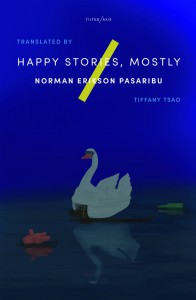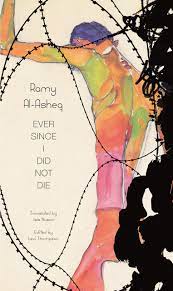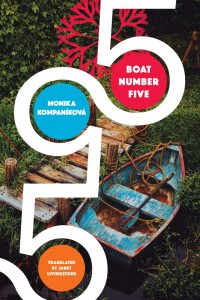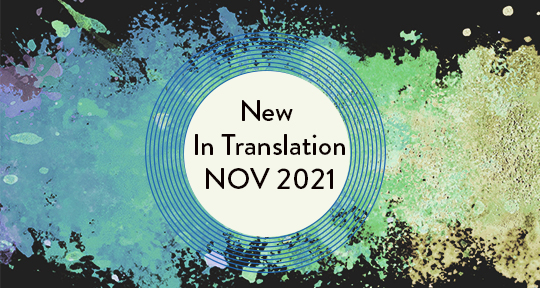This month, our selection of translated titles traverse the battlefield and the surfaces of paintings, lonely post-Communist apartment blocs and conservative spaces housing queer, radical instances of love. In language described by our editors and reviewers as potent, provocative, capacious, and full of longing, these four titles present an excellent pathway into the writers who are bringing the immediacies of experience into powerful socio-cultural commentary on our reality: Martin Hacla, Norman Erikson Pasaribu, Ramy Al-Asheq, and Monika Kompaníková.

There Are Angels Walking the Fields by Marlon Hacla, translated from the Filipino by Kristine Ong Muslim, Broken Sleep Books, 2021
Review by Shawn Hoo, Assistant Editor
Words happened. Cow became
Cow. The word milk gushed in every throat.
From this seemingly deflationary announcement that opens one of Marlon Hacla’s poems—“Words happened.”—an entire landscape is animated and given breath at the very juncture of utterance. Not only do ears of corn and a crown of birds begin to stir, so too does the speaker, finding himself transported by the magical properties of language: “I uttered the word joy / And I was once again playing a game / As a child with my friends.” Read as the collection’s ars poetica, we might say that in Hacla’s debut poetry collection, words do not simply refer to things. They move things, and each marks an occasion in the world; they sing the world into movement.
There Are Angels Walking the Fields—first published in 2010 under the Ubod New Authors Series by the National Commission for Culture and the Arts in the Philippines—opens with a lilting “Invocation,” its unbroken anaphora incanting the world of inanimate things (“In the name of the rock. In the name of the lily blossom”), of unarticulated desires (“In the name of burned / Letters from a concubine”) and of those who have been cast into the margins (“In the name of wives / Abandoned by their husbands. In the name of gay fathers”). Who could believe more in language’s ability to intervene in the world than the one who uses them in supplication? In opening the collection with this list, Hacla immediately throws his lot with the downtrodden and the forgotten—those who may not have the ability to speak—and soothes them with the divine balm of words. In her translator’s note, past contributor Kristine Ong Muslim justifies her sharpening of the poem’s decisiveness in order to heighten the quality of invocation. Thus, a line more literally translated as “In the name of hands / Not touched” becomes “In the name of hands / Never held.” Might we also consider the translator as one who practices the art of invocation—except rather than calling out in prayer, the translator calls inward, to be possessed by both languages? Where, in order for words to perform the magic of the original—for cow to become cow—something first has to happen to them? In Muslim’s translation, Hacla’s lines are screwed tight; each enjambment turns brutally, and every line sweats with a potent lyricism, as how this opening poem rollicks to an epiphany by the end:
[. . .] In the name of faces hidden.
By a black veil. In the names of ears
That had not known the sound of a violin. In the name of a flower
That bloomed in the morning and wilted by nightfall.
In your name, you who would someday die and fade away.
In its abrupt shift to the second person pronoun at the end of the poem, Hacla’s communion with the marginalised is transmuted into the universal: that we who have finite lives can only buffer against the ephemerality by being invoked by or written into language. Indeed, in this direct address, we are all drawn into Hacla’s world, where words hold the power to keep death at bay. It is perhaps also this starting invocation that allows us to look into the acts of violence that Hacla draws through various art historical traditions. For example, in a series of three portraits that glare right at the survival of sexual violence, the visuality of pain is foregrounded. Something as still as a wound starts to breathe, and trauma begins to be displaced onto the landscape: “A bracelet strung from beetles. / Behind her, the dukakak are taking off / Eastward, as this is migration season.” Equally, too, in a series of dioramas—conventionally a frozen miniature representation of a scene—the violence inflicted on the body is enjoined with the ecological and moves with it, as another unnamed “her” is described with “[l]ips like agitated mariposa butterflies.” In a whirlwind of ekphrasis, Hacla presents a radically decontextualised art tour that brings the reader from the surreal works of Hans Bellmer and Salvador Dali to the revolutionary Filipino painter Juan Luna, as well as to the poet’s own attempt at still life. Paintings and sculptures which typically lack movement are given extraordinary kineticism in Hacla’s description, in a poem such as “Spoliarium, Juan Luna”:
As a fist smashed against my eye,
My love, I glimpsed you by the wayside
The light’s cheerless shade
Entered the pupils of your eyes.
Often interpreted as an art historical and political triumph—Juan Luna won the first-class medal and bested the Spanish artists for his painting depicting slain gladiators (a piece invested with revolutionary meaning against the Spanish colonial masters by Dr. José Rizal)—Hacla opts instead, in his own Spoliarium, to reject overdetermined, nationalistic meanings in favour of something more personal: a plea from the speaker to his lover to witness him in this moment of brutality. The result is a release of these paintings from their historical trajectories, liberating their suppressed stories by engaging in a kind of decontextualised lyricism, a lyricism which acts against the calcified narratives and descriptors used to approach these canonical works.
Words are therefore also a kind of happening on these canvases, as rewriting becomes a means of rearranging the visual. Language in this book connects the verbal and the visual, the animate and the inanimate. There exists none of the cynicism towards words as something that separates us—that separates even the arts—or that banishes us to our own interiority. Through this slim work, Hacla’s skillful music develops a poetic conversation between the history of art and violence, the landscape and the viewer, person to person, and between the heavenly and the mortal. Just as the titular angels descend to walk amongst the fields, so too do the earthly transience of the languages we speak ascend into the realm of the numinous as
Night listens.
Stars jot down the words.

Happy Stories, Mostly by Norman Erikson Pasaribu, translated from the Indonesian by Tiffany Tsao, Tilted Axis Press, 2021
Review by Suhasini Patni, Editor-at-Large for India
Sandra doesn’t know much about Vietnam—what she does know is that it’s a communist country, and like Indonesia, it is a part of ASEAN. But what initiates her interest in the country is a place called Mỹ Sơn, a cluster of partially ruined Hindu temples. Its name sounds similar to that of her late son’s, whose death she is mourning. For the longest time, she has been referred to as Bison’s Mother—“submitting to the nationwide norm of calling a mother by her firstborn’s name”—but Bison’s death deprives her of any ability to be a mother, and as such, people no longer know what to call her. To reclaim her lost son, she finds her way into a temple with a sword “hidden in the depths of the lake.” Throughout this seemingly valiant mission, only the reader knows that Sandra is the reason Bison died in the first place; when she found out of his boyfriend, she no longer considered him her son. He poisoned himself, and she escaped into her own hellish nightmare.
Only a writer as gifted as Norman Erikson Pasaribu could make a story like “So What’s Your Name, Sandra?” capture all the inflections of queer life in conservative spaces. Happy Stories, Mostly is a collection of ten stories, translated from Indonesian by Tiffany Tsao, and throughout the text, Pasaribu not only portrays his upbringing in the Christian Batak community of Sumatra, but also creates narratives that replicate these realities in disorientating and often devastating ways. His work is a part of a long tradition of “queer Catholic writing,” populated with characters who are both artistic and achingly lonely. Pasaribu, who himself has suffered from hate in his home country because of his sexuality, has learned to view people, especially his own parents with a certain “kindness”; his stories, too, swell with empathy. No character is truly good or bad, nor is any story truly sad or happy.
Tiffany Tsao’s brilliant translation captures the absurdism and experimental voice of the writing. This is not the first time the two have worked together; Tsao also translated his poetry collection, Sergius Seeks Bacchus (as seen in our Winter 2017 issue), and she has been awarded the English PEN Presents and English PEN Translates awards for her efforts. When Tsao discussed the collection on her Twitter feed, she wrote: “When teeth appear in the stories, they are yellowing, sick, rotting. I got so sad while translating Norman’s stories.” It is undeniable that the stories are sad. But they are also humorous, engaging, and provocative, and each story has its own distinct voice, traversing the multiple socio-political identities of queer life in Indonesia.
In “The Giant Man: The Real Story,” a young man called Henri is haunted by a tale he was told as a kid, and he wonders if the story sticks in his mind because it originates from North Sumatra, where his “shitty father” is from. When he joins university, he starts dating a studious girl called Meta, and his only phone interactions are with his gay cousin Jamie. The story about the Giant is eventually forgotten, until he becomes friends with a particularly intelligent student, Tunggul, who reminds him of the story again. Tunggul soon confesses his love to Henri, and Henri is unable to reciprocate his feelings or even garner any sympathy for his heartbroken friend. Henri’s cousin Jamie scolds him for being so apathetic:
“If this were happening with a girl, I wouldn’t have to do anything like that!”
“It’s not the same.” Jamie’s voice sounded tense. “Think about it. Gay men don’t have many role models. This is your own friend! And right now, he feels like the most miserable person in the world.”
“What about me?” I shot back. “As if I have role models? Pass the phone to my dad then, please. Oh wait, you can’t!”
Pasaribu, too, has spoken about not having gay role models while growing up. “My mom has always been a devout Protestant. She grew up poor and Christianity gave her hope, as it did for many working-class Indonesians. My father came from a Muslim farming family, but he was orphaned when he was very young.” Yet, the first queer story Pasaribu remembers reading is from the Bible. “Both of my parents are from North Sumatra’s Toba Batak communities, one of Indonesia’s ethnic minorities. They migrated to Jakarta in the late 70s and early 80s, before settling in suburban Bekasi in 1992, acquiring immigrant-like life experiences for themselves and their children,” as he told PEN Transmissions.
Pasaribu combines his immigrant-like experience and his sexual identity, with Indonesia as the backdrop, to blend magic with the mundane. His stories cross large spaces of time in just a few sentences, and the narration switches from first person to third person effortlessly. The prose, powerful and tender, can sometimes be reminiscent of Thai author Prabda Yoon, or Filipina author Merlinda Bobis.
Happy Stories, Mostly is an enticing collection, where the smallest pedestrian acts—such as finding a secret journal or getting a cubicle to work in—have the power to force characters to question their internalized biases. While some of them operate with patience and acceptance towards homosexuality, other dismiss the relations as unnatural and vile. What is left in the middle is vacantness; an isolation that democratically affects all characters. It is this space that Pasaribu displays so well; juxtaposing the narrow crevices of hope with tragedy.

Ever Since I Did Not Die by Ramy Al-Asheq, translated from Arabic by Isis Nusair, Seagull Books, 2021
Review by Fairuza Hanun, Assistant Editor
Going back kills you.
In Ever Since I Did Not Die, Ramy Al-Asheq presents a record of his journey as a political prisoner and refugee. Compiled between 2014 and 2016 (when it was published for the first time in Arabic), these lyrical testimonies, fragmented with observation, follow a scattered timeline of his imprisonment, life across different foreign countries, and the nucleus of his childhood memories. He writes about war in varying degrees, dissecting it into its discrete elements: the camp, “ginger on the back of humanity’s infected throat”; the mortar, “a tiny cosmic explosion that rearranges habitats by the whims of whomever launches it”; bombs wrapped in gifts and the innocent happiness they detonated; and death—a capital, a mass biological and mental debilitation, the sound of it intensified as white noise. Each word is concentrated, an accumulation of metaphors harnessing an intense energy of rage and desire for justice. To be Palestinian and Syrian, he writes, is to be “the son of two deaths [. . .] Whoever is not killed by both is killed by one and stays alive in the other, a dead soul wandering without a tomb.”
Criticising the cruel deportation of Syrian and Palestinian refugees who seek asylum at the border of Jordan, Al-Asheq describes the continuous cycle of war, death, and refuge—the completion of one act reproducing the next, its mundanity obscuring its origins, and the pervasive danger of seeing conflict as a natural constant, breeding ignorance in turn. This unrelenting rhythm shadows refugees everywhere, across borders and into their various worlds; fear becomes a currency for survival, and names and identities are received and expended in equal measures of desperation and carelessness. The author denigrates this amnesiac practice, stating that upon procuring a new citizenship, one seeks to leave their origins and people behind, because this is what war and selective safety asks of you. In the attempt to conform with their new “home,” they practice their “Otherness on others.”
This is how one refugee killed another when the first became an Other. It was necessary for the second to keep the title so as to not turn into nothing.
This connects to the subject of victimisation, privilege, and other dualities within conflicts and shifts of identities. Al-Asheq refers to writer and journalist Ammar Ahmad Al-Shuqairy’s encapsulation of a mortar launcher’s existential crisis in The Storytellers as Themselves, who believes itself that it “cannot exist . . . unless there is a refugee.” In response, Al-Asheq questions: “Is it our instinct to always blame the victim? Is it customary for the victim to keep playing this rule [or role] even after the decided time has passed? The victim might even like it and consider it a privilege.” This way of thinking kindles a justification of causing and reliving trauma and pain, striking up a duality that is experienced by all internal and external bodies of war—the oppressor and the oppressed versus the international spectator: “an essential existential component of the dualities . . . that are always . . . subject to unilateral rule”—that “[g]ood is sometimes evil, and wrong right.”
Simultaneously, in the matter of discourse and memory, Al-Asheq discusses humanity in all its flawed facades and facets. Heroism, according to him, “is an absolutely individual victory.” Ever since, as in the title, he did not die, he pronounces his hatred for heroism as it is often tied in with martyrdom—death crowning one a hero. Rather, he handles reality into the shapes of poetry, thrashing against the stifling media narrative of resilience which mistakenly paints suffering as being tolerable, and exposing the wounded aspect of being someone cast into violence because of one’s identity—which should be “everything except for place, flag, race, religion and gender.” Emphasising on the capacity for betrayal of even fellow refugees, the author insists that ascribed roles are not what keep us together; rather, blood and a soul are what make us human. Blood, other than a signifier of pain and death, is remade into an imagery of warmth that, if taken, renders our bodies pale and incapable of tenderness and love.
The narrative flits from one use of pronoun to another—a multicoloured tapestry of anonymous voices, figures, and identities. They stand on their own in their penetrating testimonies and criticism, because, after all, “[w]ho stands with the revolution other than your voice in this din of barking and wailing”? The absence of names—with only the occasional initial for the sake of reference—protests the concept of neoliberal revolution that feels more akin to tokenism; in voiding titles and signifiers, Al-Asheq subverts both the use of titles as an honorary mention that society uses to cast its martyrs, as well as the eventual neglect of names, falling off the tips of tongues as easily as the names of roads.
[People] stole the features of your death from the face of a monster. They whipped you like they had before. They pulled a song like a rope around your neck and trapped you in a lap that pronounces your name. [. . .] They drew you as a stranger in bathrooms full of addicts in order to grow stories in the consciousness of interrupted narratives. Every man with a bad reputation suddenly becomes generous and pure. Here you are cutting down the black tree in your mind like a garden of absence, filling in your presence with different colours that have one name. The colour black does not look like you, and you do not look like it. No one accepts an honest mirror.
In this powerful account, Al-Asheq grips his readers in a language brimming with intimate pain, longing, and anger, and calls for justice for the continuous death and debilitation that is somehow replete in life.

Boat Number Five by Monika Kompaníková, translated from the Slovak by Janet Livingstone, Seagull Books, 2021
Review by Georgina Fooks, Director of Outreach
Twelve-year-old Jarka is a daydreamer, and her dreamscape is full of water—leaking boats, lakes, endless oceans. In one memorable fantasy, Jarka is lost in the water, frantically swimming towards four boats, each containing people who represent the possibility of safety and security: her Freudian father figure, her reckless mother, her cold grandmother, and the fellow children she’s selected to make up her new family. Yet—there is a fifth boat too: reserved, if she chooses, for Jarka alone. In Monika Kompaníková’s Boat Number Five, translated from the Slovak by Janet Livingstone, we follow her quest to find a sense of safety, amidst the sea of chaos that is her life.
It quickly becomes apparent that our protagonist’s daydreams are a coping mechanism—a habit evolved for escaping the troubles and chores of her post-Communist apartment block in Bratislava. Born to a teenager, Lucia, who insistently rejects the responsibility of motherhood (“Don’t call me Mama she said over and over again, I feel like an old cow when you do.”), Jarka is confronted with more responsibilities than the typical twelve-year-old. Her grandmother Irena is a fierce former headmistress who denounces Lucia’s pregnancy, only begrudgingly letting Jarka and Lucia come home once she requires assistance in her old age—a relationship characterised as “commercial.” Still, Jarka attends to her adult relatives, becoming a caregiver for those who should be protecting her.
When her heartless grandmother passes away, Jarka and Lucia are set adrift in the apartment, fending for themselves. Lucia’s comings and goings are erratic and chaotic, and when she is home, she plays host to a series of drunken girlfriends and predatory boyfriends, all of whom threaten Jarka’s security in one way or another. Despite the lack of any meaningful structure, Jarka forms her own precarious version of a domestic routine, taking care to cause as little trouble as possible. While other kids envy her constant freedom—no bedtimes and no rules—it comes at a cost:
Sometimes Lucia and I didn’t even speak to each other for 10 days. And I told myself that love doesn’t require words. There was some song that went like that.
The violence innate in this neglect is palpable in the writing’s direct, first-person immediacy. We internalise Jarka’s discourse: Lucia is almost never described as “Mama,” so on a linguistic and emotional level, her mother is abdicated from the role of motherhood. She cannot be a mother if she resists her title. While our narrator undoubtedly loves her mother, their bond is an insecure attachment, leaving Jarka to turn elsewhere for sanctuary; she finds peace and safety in her grandfather’s abandoned garden, an unspoiled natural kingdom where she can freely daydream. It is this place that she eventually transforms into the home she yearns for.
The utter absence of adult guidance in her life occasionally means that Jarka can sample certain freedoms from the consequences of their irresponsibility, finding refuge on her own terms. This innocent desire for unconditional, familial love takes a drastic lurch, however, with Jarka’s impulsive abduction of twin babies from a train station, justifying the act with her own, ingenuous logic: “She knows how to take care of everything, she’ll take care of them too.” With a telling slip into the third person, the prose takes one step back to face this situation, as Jarka—befitting a child’s response to abandonment—makes impossible leaps, deciding to give these babies the mothering she never had.
The novel bears witness to the brutal lyricism of trauma and its dissociations, and its matter-of-factness cuts like a knife. Among meandering repetitions and shifts from childhood to adulthood, the writing slips between past and present with such fluidity that it’s hard to detect any changes in the character’s circumstances, repealing the traditional insistence on chronological healing and recovery. The novel both opens and closes with an image of a dead cat—the first found by Jarka, and the latter by the neighbourhood youth as she looks back nostalgically on her past, wistfully regretting the friendships that were never formed. Though the setting changes little, these ebbs and flows of past and present throughout the novel nonetheless gives way to a maturing perspective—the gift of distance and hindsight.
History is a tentative presence in the narrative, like waves lapping at the edge of the story, and the descriptions of industrialised Bratislava allude to the historical context of the novel. In one of Lucia’s drunken and fragmented ramblings, during a particularly hypnotic moment of translation, we are reminded of how life used to be:
Lots of babies . . . just like you . . . we waited for the table like they waited in line for oranges [. . .]
In this reminiscence, Lucia alludes to the difficulty of giving birth as a teen mother in a majority-Catholic country, grounded in an analogy that recalls the food shortages that mark the country’s past. Nonetheless, this is a narrative anchored in a child’s experience, so understandably, little is made of history; instead, there is an intentional focus on the sensualities of experience. The past is made concretely present, as seen in the sections that treat the inhabitants of Jarka’s apartment block as a microcosm for Slovakia’s changing society. These apartment buildings, abundant across the country, evidence the ways history seeps into the architecture, into the fabric of our lives.
Janet Livingstone’s translation is capacious, allowing for these resonances of history to rub up against the uncohered present, and carefully renders the simple lyricism of Kompaníková’s free prose:
The grape leaves were rustling, tempting me to continue along the road. I knew that dusty, ripe grapes and edible chestnuts awaited me. And memories inside them like coiled up worms.
Boat Number Five is one of two books that Seagull Books has chosen to launch their Slovak List, introducing a unique prose stylist whose work serves to enrich Anglophone readers’ understanding of Slovakia. Bypassing stereotypes and delineating universal human ideas of love, care, and wish fulfilment through compelling storytelling, Kompaníková’s work is a powerful study of trauma, distilled in a single individual search for genuine, human connection.
*****
Read more on the Asymptote blog:

